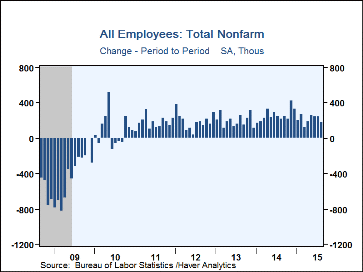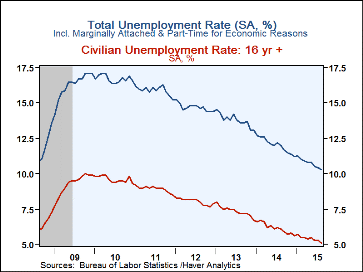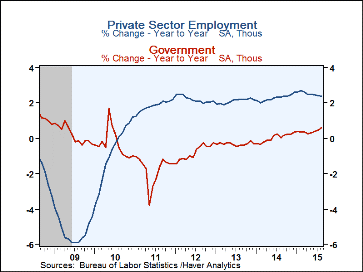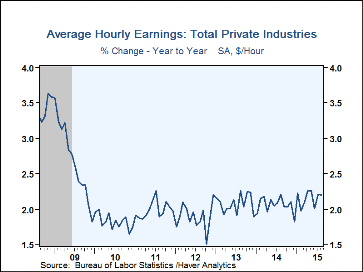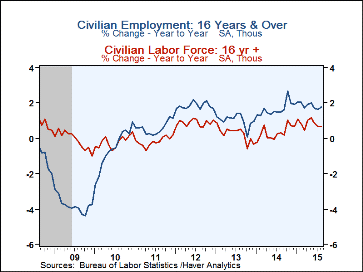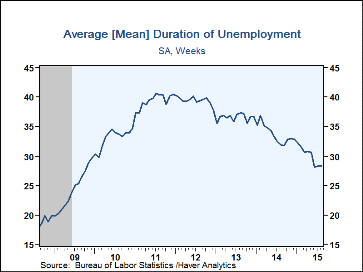 Global| Sep 04 2015
Global| Sep 04 2015U.S. Payroll Employment Increase Weakens; Jobless Rate Falls to 2008 Low
by:Tom Moeller
|in:Economy in Brief
Summary
Last month's increase in payroll employment disappointed expectations and rose 173,000 (2.1% y/y), the weakest increase since March. A gain of 215,000 had been expected in the Action Economic Forecast Survey. The July increase was, [...]
Last month's increase in payroll employment disappointed expectations and rose 173,000 (2.1% y/y), the weakest increase since March. A gain of 215,000 had been expected in the Action Economic Forecast Survey. The July increase was, however, revised upward to 245,000 from 215,000 and the June gain was revised higher as well, also to 245,000. Private sector employment rose 140,000 after a 224,000 increase. Government hiring strengthened 33,000, its best in two years. Average hourly earnings posted a 0.3% rise (2.2% y/y), above expectations for a 0.2% increase. The unemployment rate fell to 5.1%, its lowest level since April 2008. A 5.2% rate had been expected in the Action Economics Forecast Survey. The overall unemployment rate, including marginally attached workers and those working part-time for economic reasons, fell to 10.3%.
From the payroll survey, the 173,000 jobs increase followed two consecutive months of 245,000 increase. So far this year, payrolls have gained an average 212,000 per month, below the 260,000 averaged during all of last year. In August, factory sector employment fell 17,000 (+0.9% y/y), its first decline since July 2013. Declines were widespread amongst industries. Construction sector jobs increased 3,000 (3.4% y/y), down from the 28,000 averaged per month last year. Employment in the mining sector fell 9,300 (-10.6% y/y) and has declined during each month this year.
Private service sector jobs rose 164,000 (+2.6% y/y), the weakest rise since March. Retail trade jobs rose 11,200 (2.1% y/y), down from 18,600 averaged last year. Professional & business services jobs increased 33,000 (3.3% y/y), off from last year's 59,000 average. Temporary help jobs grew 10,700 (4.4% y/y) after a 9,200 decline. Elsewhere, job growth remained firm. Jobs in health care & social assistance rose 56,400 (3.1% y/y) and have been strengthening from a 35,200 average last year. Leisure & hospitality employment rose 33,000 (3.0% y/y) but that's down from last year's 40,000 average. Financial sector jobs grew 19,000 (2.1% y/y), up from last year's 11,000 average. Government sector employment improved 33,000 (0.6% y/y) on the strength of a 22,000 increase (0.5% y/y) in local government hiring. That's up from a 5,000 monthly average last year. State government jobs rose an improved 9,000 (0.8% y/y) and federal sector jobs increased a stable 2,000 (0.3% y/y).
Average weekly hours worked improved to 34.6, equaling the highest level of the economic expansion. Aggregate hours worked (employment times hours) gained 0.4% (2.7% y/y). For the third quarter so far, aggregate hours rose at a 2.3% annual rate versus a 1.0% Q2 advance. During the last ten years, there has been a 67% correlation between the quarterly gain in aggregate hours and the change in real GDP.
Average hourly earnings grew 0.3% following an unrevised 0.2% increase. It was the strongest monthly increase since March. Factory sector earnings grew 0.4% (1.7% y/y) after a 0.5% gain. Together, these increases are the strongest since the middle of 2010. Private service sector earnings grew 0.3% and at an improved 2.3% y/y.
From the household employment survey, the decline in the unemployment rate to 5.1% reflected a 196,000 rise (1.8% y/y) in employment and a 41,000 decline (+0.7 y/y) in the labor force. The population grew 0.1% (1.2 y/y), therefore the labor force participation rate remained at 62.6%, the lowest level since October 1977. The number of eligible individuals not in the labor force grew 2.0% y/y, still strong against a peak rate of 2.9% during all of 2010. The participation for individuals aged 16-24 years old has been stable near 25.0% but for adults it has declined to 64.0%.
The average duration of unemployment was fairly steady at 28.4 weeks, down from 39.4 weeks averaged in 2011 and 2012. The percentage of those unemployed and were out of work for a year or more was 17.2%, down from 31.4% averaged in 2011.
The unemployment rate for individuals with less than a high school diploma was 7.7% and for high school graduates but no college it was 5.5%. For those with some college but without a degree the jobless rate was 4.4% and for college graduates or higher it was 2.5%.
The labor market data is contained Haver's USECON database. Detailed figures are in the EMPL and LABOR databases. The expectations figure is in the AS1REPNA database.
The Cyclicality of the Opportunity Cost of Employment from the Federal Reserve Bank of Minneapolis can be found here.
| Employment: (SA M/M Change, 000s) | Aug | Jul | Jun | Y/Y | 2014 | 2013 | 2012 |
|---|---|---|---|---|---|---|---|
| Payroll Employment | 173 | 245 | 245 | 2.1% | 1.9% | 1.7% | 1.7% |
| Previous | -- | 215 | 231 | -- | -- | -- | -- |
| Manufacturing | -17 | 12 | 1 | 0.9 | 1.4 | 0.8 | 1.7 |
| Construction | 3 | 7 | 1 | 3.4 | 4.8 | 3.7 | 2.1 |
| Private Service Producing | 164 | 211 | 221 | 2.6 | 2.2 | 2.2 | 2.2 |
| Government | 33 | 21 | 27 | 0.6 | 0.0 | -0.3 | -0.8 |
| Average Weekly Hours - Private Sector | 34.6 | 34.5 | 34.5 | 34.5 (Aug.'14) |
34.5 | 34.5 | 34.4 |
| Private Sector Average Hourly Earnings (%) | 0.3 | 0.2 | 0.0 | 2.2 | 2.1 | 2.1 | 1.9 |
| Unemployment Rate (%) | 5.1 | 5.3 | 5.3 | 6.1 (Aug.'14) |
6.1 | 7.4 | 8.1 |
Tom Moeller
AuthorMore in Author Profile »Prior to joining Haver Analytics in 2000, Mr. Moeller worked as the Economist at Chancellor Capital Management from 1985 to 1999. There, he developed comprehensive economic forecasts and interpreted economic data for equity and fixed income portfolio managers. Also at Chancellor, Mr. Moeller worked as an equity analyst and was responsible for researching and rating companies in the economically sensitive automobile and housing industries for investment in Chancellor’s equity portfolio. Prior to joining Chancellor, Mr. Moeller was an Economist at Citibank from 1979 to 1984. He also analyzed pricing behavior in the metals industry for the Council on Wage and Price Stability in Washington, D.C. In 1999, Mr. Moeller received the award for most accurate forecast from the Forecasters' Club of New York. From 1990 to 1992 he was President of the New York Association for Business Economists. Mr. Moeller earned an M.B.A. in Finance from Fordham University, where he graduated in 1987. He holds a Bachelor of Arts in Economics from George Washington University.


